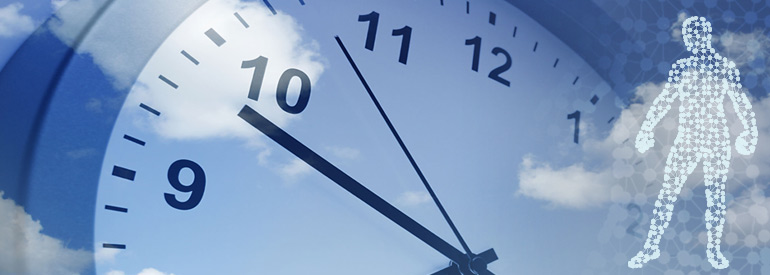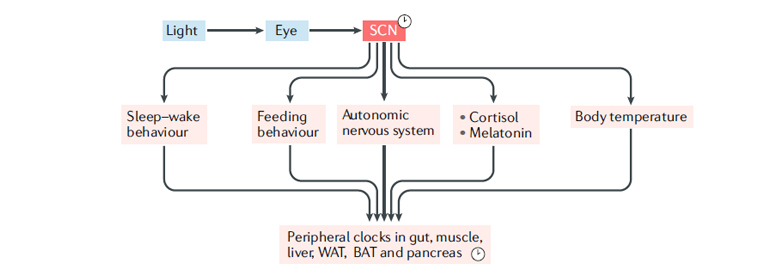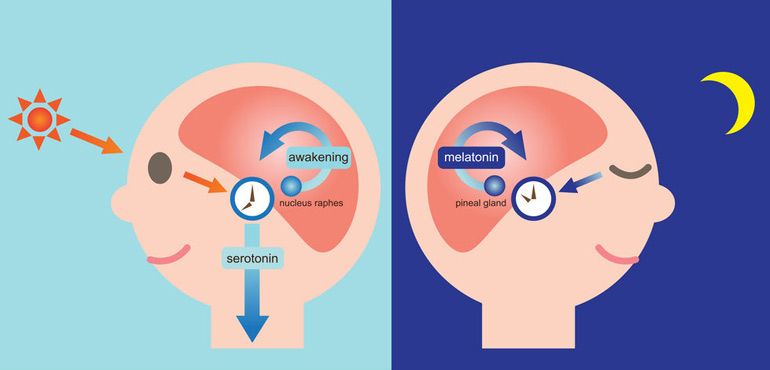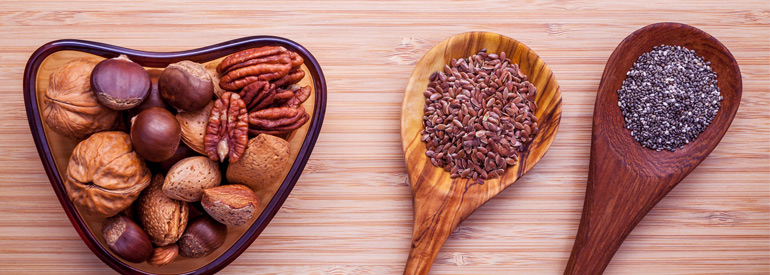
Circadian rythms and metabolism

Circadian cycle: does the biological clock exist and is it related with metabolism?
The 2017 Nobel Prize for the Medicine or physiology has been assigned to three north Americans researchers for their discovery on the molecular mechanisms which controls the circadian rhythms.
The circadian term is attributed to the physiological phenomenon related to day-night rhythm; the origin is Latin and came from two words: “circa” approximately and “dies” day. The human being like any other living being has an internal clock that has developed during the evolution on this planet as a result of the nature cycles.
For example, following an ideal rhythm, early in the morning, we assist a body temperature increase, a reduction of circulating melatonin, a pick of cortisol and the predominance of the sympathetic nervous system (SNS). These neuro-hormonal changes predispose the body to the assumption of a good energetic meal and the performance of all the daily activities with the predominance of the glycolytic metabolism. At dusk begin a sequin of opposite mechanism that lead to the nightly faze of fasting, allowing, during this time lapse, the secretion of leptin and all the energetic antioxidant phenomenon, like the fats catabolism. A good quality and quantity of sleep assure the production of GH (growth hormone), guarantees the correct operating of restoration and cleaning cellular mechanism, including the neuronal one (BDNF brain neurotrophic factor), needed for the efficiency preservation of human biological machine. (1)
Modulation of the Circadian Rhythms with the lifestyle:
Nutrition, physical activity and sleeping are three lifestyle pillars that contribute to the safeguarding of the human health and are important circadian rhythms modulators.
In this integrated health vision with the physiology and chronobiology it is all about what, how much and when do we have to eat, exercise and sleep during the 24 hours.
If the natural rhythms are ignored and unsynchronized from itself, the internal metabolism will alternate, for example the glucose metabolism and the insulin resistance, contributing to a major susceptibility compared to pathologies, like cardio metabolic and neurodegenerative ones (1,2).
Circadian Rhythm in the 21st Century:
The current lifestyles are characterized by a poor natural light exposure and the use of the artificial light prolonged within the late-night hours. Regarding the nutrition, comparing it even only with two past generations, exist a much longer food intake time laps, which do not provide a long night fasting and not permitting the optimal energy purposes oxidation of the fat ‘storage.
How does the Circadian system work?
When a ray of light heats our retina, it induces a neuronal signal that activate the suprachiasmatic core of the hypothalamus, where resides so-called Master Clock and form here leaves the hormonal messages turned to the rest of the human body. Every single organ owns a periphery clock, which it’s synchronized from the central signal that works like a metronome. At the molecular level, every single cell has an internal clock that regulate the transcription of thousands of genes.
Are all light types identical?
The melanopsin, a protein produce by the eye retina, is activated only by some luminous frequency ranges. The photoreceptors are stimulated by the natural day light, and only partially by the artificial light of the incandescent bulbs, while on the contrary the screens blue light and the cold led lights lead to the stimulus activation.
It exits special lenses that act as a filter for the light frequencies and stimulate the retinal photo receptors and therefore the Central Nervous System (CNS). This kind of glasses serve not to inhibit, due to the light, the melatonin secretion that normally take place in the very first night hours and provide the regular sleep circle.
Food as a circadian regulator:
The food is an important circadian regulator because it is able to synchronize the Central Nervous System (CNS) clock with all the periphery clocks. Remember that most of the organs possess a biological clock and has its own rhythm which also occurs for the microbiome. The optimization of circadian synchronicity is linked to the meal intake signal, which should be maximum during the day phases when the glucocorticoids activation and the SNS is high (breakfast and lunch) for supporting the major human activity periods. Towards evening, in reverse, the dinner should have a light energy load and should be consumed early in the evening. It is obviously that this kind of “timing” it is very different from that one that our society has adopt, but it is alike to that of our grandparents and it is steel diffuse in some rural and mountain areas.
Experiments conducted at north American Salk Institute for Biological Study show interesting results regarding, in particular, the same diet on an animal model divided into two groups:
- the first group feed within a 15 hours’ time leaps
- the second one, with a shorter time leap (time-restricted feeding) of 8-10 hours
After 18 weeks, the first group subjects were obeses and show signs of pathologies; meanwhile the second group subjects were in good health. The interesting part of this experiment is the return at the normal weight and good health of the first group subjects following the time restricted feeding (3).
Although being in an continues evolution, it is clear that the use of the time leaps (time restricted feeding) and the circadian have an extremely impotence for the human being health and for the maximum performance achievement. Practically, the science confirms that fact that the traditional cultural heritage faded over the centuries has been interrupted by the recent technological development.
A look at lipids from the point of view of circadian rhythms:
The metabolic effects of circadian rhythms also involve the homeostasis of lipids, affecting the levels of circulating fats and their deposits and/or liver accumulation. Dyslipidemia and obesity are found in those who have disturbed circadian rhythms, as in shift workers or in laboratory animal models. A recent study conducted on a population of over 1,000 subjects shows a correlation between the intake of more abundant meals in the late evening (over 8:30 pm) with higher circulating values of total cholesterol and LDL (bad). This result seems to be explained by the higher degree of intestinal absorption of fats in the evening hours and by the increased liver synthesis of cholesterol in the late evening (4).
Bibliography
(1) Figure taken from: Stenvers D.J. et al. Circadian clocks and insulin resistance. Nature Reviews Endocrinology. 2019. Volume 15, pages75–89 (2019).
(2) Abbott S.M. et al. Health implications of sleep and circadian rhythm research in 2017. The Lancet neurology Vol 17 January 2018.
(3) Hatori M. et al. Time-restricted feeding without reducing caloric intake prevents metabolic diseases in mice fed a high-fat diet. Cell Metab. 2012 Jun 6;15(6):848-60.
(4) Chen H.J. et al. Energy intake at different times of the day: Its association with elevated total and LDL cholesterol levels. Nutr Metab Cardiovasc Dis. 2019 Jan 14. [Epub ahead of print]
Article by:
Dr. Francesco Bonucci – Nutrizionist
Photo: 37598782 ©stillfx/123rf.com | 52403467 ©yomogi/123rf.com
- On 29 March 2019





